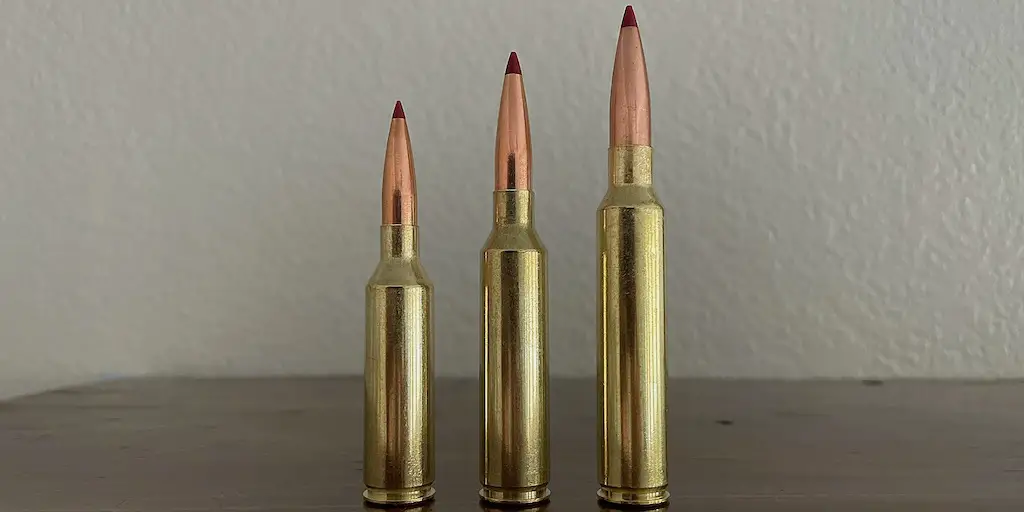Need a cartridge that delivers hard hitting performance at extended range and can’t decide between the 300 PRC vs 338 Lapua Magnum?
Though the 338 Lapua Magnum only came on the scene pretty recently in the 1980s, the heavy hitting cartridge quickly gained notoriety among hunters and shooters as a result of some high profile use in the hands of military snipers. However, the even newer 300 Precision Rifle Cartridge exploded onto the scene in 2018 and has challenged the mighty 338 Lapua Magnum’s dominance at extended range.
The 338 Lapua Magnum seems to have a lot of things going for it: it’s a gigantic and powerful rifle cartridge with great performance on paper and an excellent reputation at the range, afield, and on battlefields during the nearly four decades it has been around.
However, the 300 PRC is a much newer, more efficient cartridge that employs more modern cartridge design techniques to deliver impressive ballistic performance without as many of the downsides of the 338 Lapua Magnum.
With those things in mind, it’s not surprising that many shooters and hunters looking for a new rifle for use at longe are considering the 300 Precision Rifle Cartridge and the 338 Lapua Magnum.
Both offer undeniable advantages to hunters and there’s lots of overlap in their capabilities, but there are some important differences between the 300 PRC vs 338 Lapua cartridges you should keep in mind.
In this article, I investigate the 300 PRC vs 338 Lapua Magnum and provide insight on the pros and cons of each rifle cartridge along with recommendations on which one is best suited for various hunting situations so you can decide which one will work best for your individual needs.
Table of Contents
History Of The 338 Lapua Magnum & 300 PRC
The .338 Lapua story begins in 1983 when Research Armament Company began development of a new long range sniper round for military use. Specifically, those designers wanted a flat shooting and hard hitting round that could fire a 250 grain .338″ bullet at 3,000fps that was more powerful than the 7.62x51mm NATO without requiring as large or heavy of a rifle as the .50 BMG.
Formally introduced by Lapua Limited in 1987, the designers of the .338 Lapua Magnum (also known as the 8.58x71mm) accomplished those goals by utilizing a new case based on the .416 Rigby.
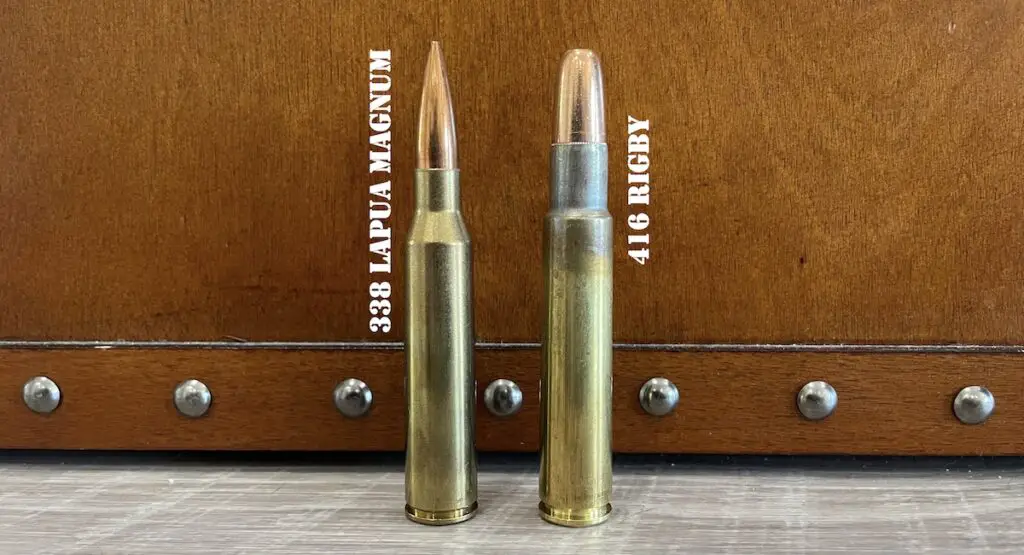
Though they experienced their share of challenges and difficulties along the way, the designers of the cartridge eventually accomplished their goals and typical 338 Lapua Magnum ballistics are a 250gr bullet at just over 3,000fps (about 5,095ft-lbs) or a 300gr bullet at nearly 2,800fps (about 5,150ft-bs).
For reference, the 338 Lapua has more muzzle energy than noted big game rounds like the 375 H&H, 416 Rigby, and 404 Jeffery and nearly the same energy as the 458 Winchester Magnum.
The .338 Lapua is now very highly regarded as a long range cartridge and has seen extensive use in the hands of military snipers from numerous countries. In addition to having a really long effective range and having lots of stopping power, the cartridge is also (allegedly) capable of penetrating military body armor at ranges in excess of 1,000 yards.
Though the record has since been broken (Ukrainian sniper Viacheslav Kovalskyi holds the current record after he killed a Russian officer at 3,800 meters in November 2023 using a 12.7x114mm round), British Army sniper Corporal of Horse Craig Harrison used a 338 Lapua Magnum when he set the record for the longest sniper kill at the time back in 2009.

Harrison used a Accuracy International L115A3 sniper rifle chambered in .338 Lapua Magnum to kill two Taliban machine-gunners 2,707 yards (2,475 meters or just over 1.5 miles) away in Afghanistan’s Helmand Province.
That engagement actually surpassed the normal maximum effective range of the 338 Lapua, but fortunately for Harrison and unfortunately for the Taliban, conditions were perfect and he ended up hitting each insurgent with a single shot.
American sniper Chris Kyle also used a McMillan-built TAC-338 in .338 Lapua to achieve his longest personal kill of 2,100 yards (1,920 meters) in Iraq back in 2008 (American Sniper, p398-399).
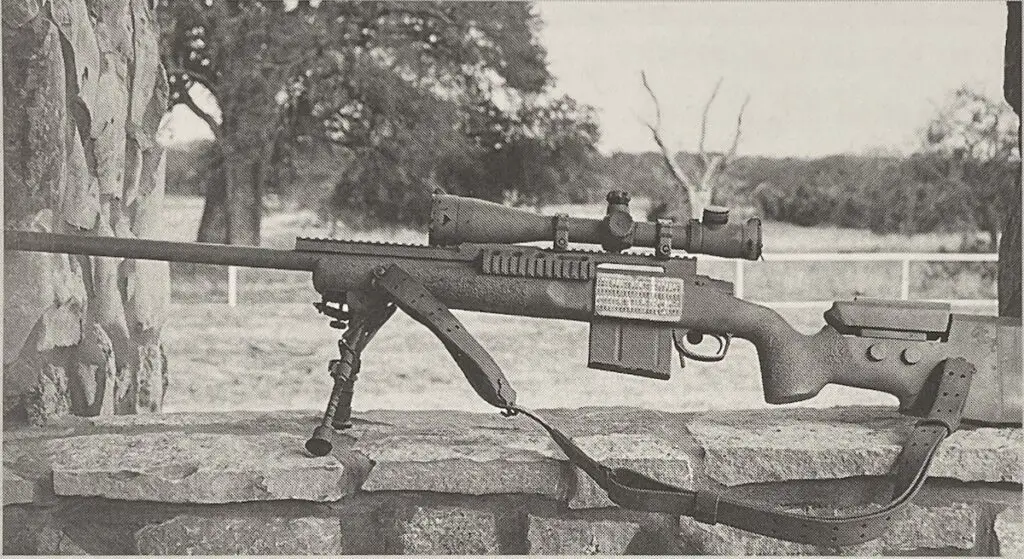
Both of those situations demonstrate the capabilities of the 338 Lapua Magnum cartridge at extended range and helped cement the 338 Lapua’s reputation as a heavy hitting long range cartridge.
As successful as the round was in military use, the .338 Lapua has also crossed over into the hunting community in recent years. Though few hunters have a need to utilize the extreme long range capabilities of the cartridge, the .338 Lapua is still capable of delivering more power at longer range than just about any other comparable round.
As we’ll discuss in more detail here shortly, the Lapua also utilizes very aerodynamic bullets that retain energy and resist wind drift exceptionally well.
The cartridge is also devastating on all manner of game at closer range.
You can learn more about how the 338 Lapua Magnum compares to the 300 Win Mag and 338 Win Mag in the article below:
300 Win Mag vs 338 Lapua vs 338 Win Mag Comparison
Now let’s shift gears and talk about the new kid on the block in the 300 Precision Rifle Cartridge.
According to the folks at Hornady, the 300 PRC came about as a result of a request from the United States Department of Defense for a rifle cartridge with a longer effective range than the 308 Winchester (7.62x51mm NATO) and 300 Winchester Magnum rounds commonly used by US Military snipers at the time.
While the 308 and 300 Win Mag worked great for engagements out to 800-1,200 meters, the military wanted a rifle cartridge with an even longer range they could use in places like Afghanistan where engagements could potentially occur at absurdly long ranges.
As you can see in the photo below, you can see a long way in many parts of that country!
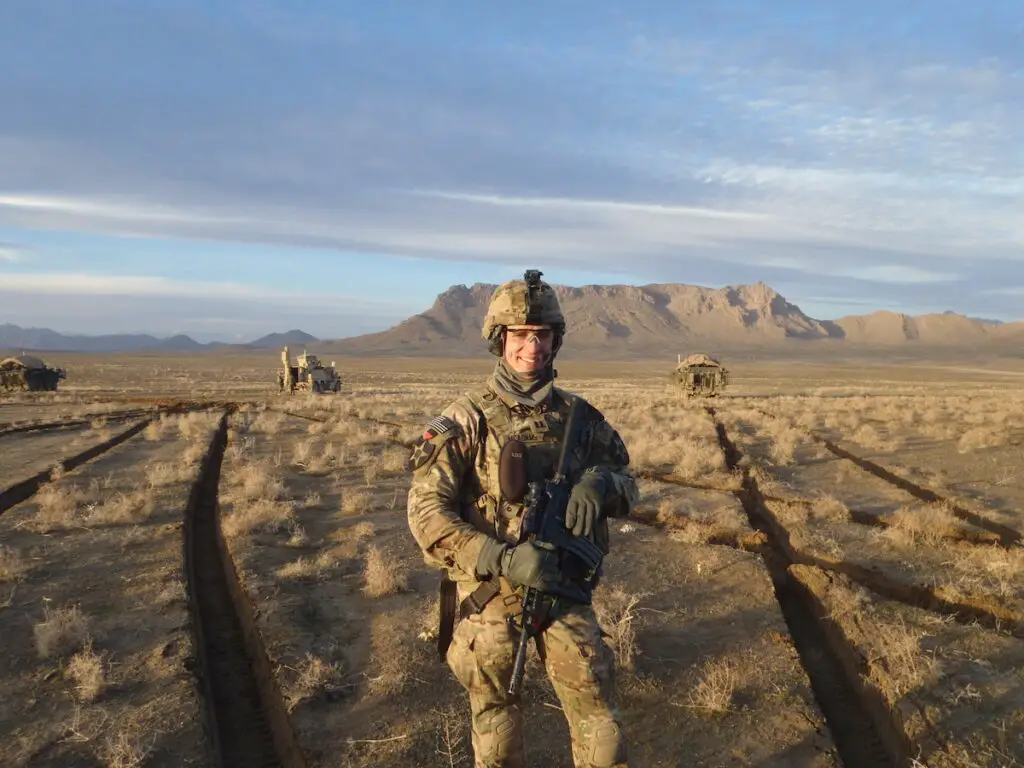
The military ended up purchasing rifles in a number of different cartridges to fill this need (like the 300 Norma Magnum, 338 Norma Magnum, and 338 Lapua Magnum).
However, Hornady also designed what they considered the ideal 30-caliber magnum specifically for this purpose as well.
They had to do this because none of the existing .30 caliber cartridges at the time were well suited for using extremely long, high BC bullets.
Rounds like the 300 Remington Ultra Magnum (300 RUM), 300 Weatherby Magnum, and 30-378 Weatherby Magnum could push a .30 caliber bullet with a moderately high BC at very fast (and even potentially insanely fast in the case of the 30-378 Weatherby) velocities. However, the simple truth was that none of those rounds really had the great extended range performance some people were looking for.
Sure, they shot really flat and carried a lot of energy out to several hundred yards, but they also didn’t perform well in windy conditions and lacked the staying power to be ideally suited for use at ranges past 1,200 yards.
Interestingly, Joe Thielen at Hornady developed what would become the basis for the 300 PRC as a side project in the early 2000s he thought would be ideally suited for his personal long range recreational shooting and hunting pursuits.
Instead of building a cartridge based on existing design constraints imposed by the various common action lengths (short action, standard/long action, etc.), he decided to just build a cartridge designed specifically to do what he wanted, then build a custom rifle around it.
He started off with a big 30 caliber round that was essentially an 8×68 S necked down to shoot .308″ bullets. While it worked fine, he struggled to find brass.
Thielen saw a big opportunity for improvement when Hornady released the 375 Ruger in 2007 though.
The .375 Ruger was the end product born of a collaboration between Hornady and Ruger they built to deliver the same sort of performance as the legendary 375 H&H Magnum, but do so out of a standard length rifle action instead of requiring a longer magnum length action like the 375 H&H.
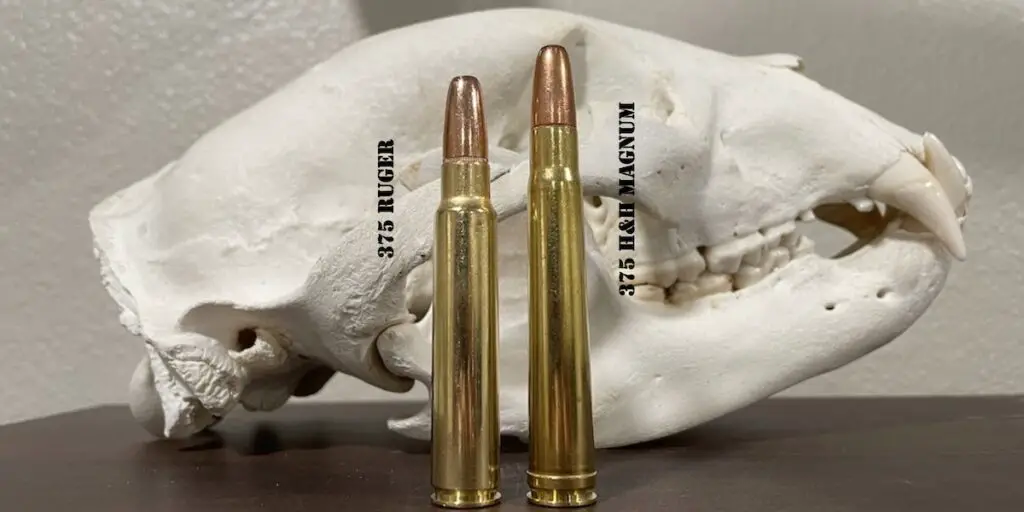
While the .375 Ruger has the same .532″ case head diameter as the .375 H&H, the 375 Ruger is a beltless cartridge and the actual body of the .375 Ruger case is larger in diameter than the .375 H&H. The 375 Ruger also has quite a bit less body taper than the 375 H&H.
The end result is a shorter and fatter round that delivers 375 H&H level performance out of smaller, handier, and less expensive rifles.
So, Thielen necked down a .375 Ruger cartridge case to shoot .30 caliber bullets and built the cartridge with a very long head height.
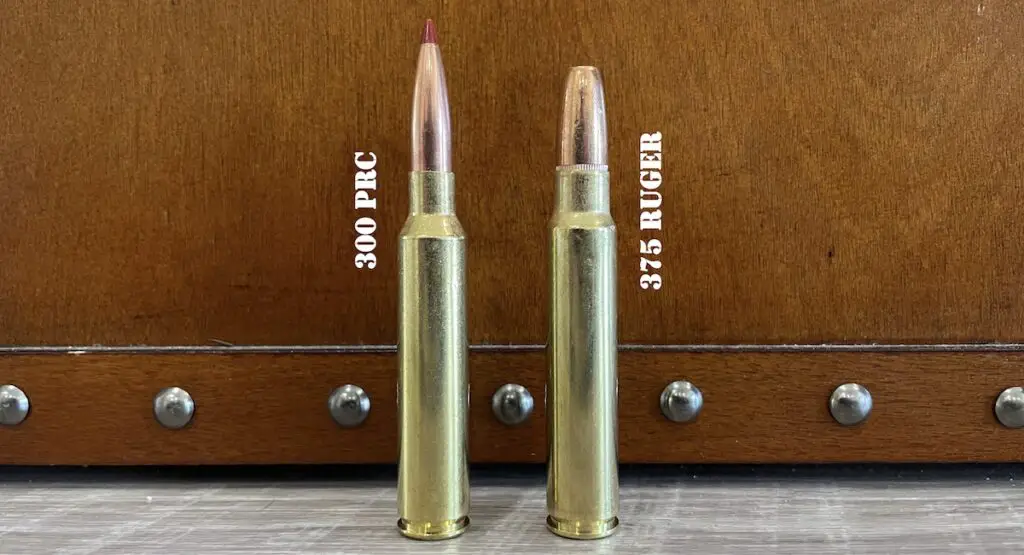
Head height is the amount of space available for the bullet outside the case while staying within SAAMI specifications for the cartridge. Put simply, more head height facilitates the use of very long, aerodynamic bullets.
We’ll discuss this more later, but to calculate head height, subtract the case length of the cartridge from the maximum overall length.
After making some slight modifications and refinements to Thielen’s basic design, Hornady submitted their new 30 caliber magnum cartridge to the Sporting Arms & Ammunition Manufacturer’s Institute (SAAMI) for approval as well as to the United States Department of Defense for potential use by the military.
As is the case with many cartridges designed for military use (like the 223 Remington, 308 Winchester, and 30-06 Springfield), the staff at Hornady also saw lots of potential for use in the sporting realm for the 300 PRC as well.
For this reason, Hornady formally launched the 300 PRC it at the 2018 National Association of Sporting Goods Wholesalers (NASGW) show in Pennsylvania in conjunction with it’s smaller sibling in the 6.5 PRC after it received SAAMI approval in August of 2018.
Both of the Precision Rifle Cartridges also made a big splash and headlined Hornady’s list of new products at the 2019 SHOT Show a few months later (Hornady released another member of the family in 2023 in the 7mm PRC to great fanfare as well).
The United States Department of Defense also purchased a number of MRAD DOD 300 PRC variants of the Barrett MRAD rifle chambered in 300 PRC for use with United States Special Operations Command (USSOCOM) in 2019 and 2020.

Typical 300 PRC ballistics are a 212gr bullet at 2,860fps (3,850 ft-lbs) or a 225 gr bullet at 2,810fps (3,945 ft-lbs). Both loads use long, aerodynamic, heavy for caliber bullets that minimize bullet drop and wind drift at extended range.
Like I mentioned earlier, Hornady developed the 300 PRC to fix some performance issues with the older 30 caliber magnums that existed at the time, especially at extended range.
Here’s what Dave Emary had to say about that subject in more detail:
The .300 PRC was an attempt to basically fix that and create something that doesn’t suffer from shoving the bullet down into the case; doesn’t suffer from a case that’s so big that there’s not a powder that fills it up well enough to get really low standard deviations and things like that. That is what we’re after. The goal is to have something that will easily handle the long, heavy, high-performance style, .30-caliber bullets with the greatest consistency possible for extended long-range shooting.
In that vein, and in addition to having ample head height for use with long, high BC bullets like I mentioned earlier, 300 Precision Rifle Cartridge rifles also usually have a relatively fast rifling twist rate (SAAMI spec is 1:8.5″) in order to stabilize those high BC bullets.
We’ll discuss the details later in this article, but the 300 PRC also utilizes many of the same accuracy enhancing modern cartridge design principles as other new cartridges with incredible reputations for accuracy like the 6.5 Creedmoor, 6.5 PRC, 6.8 Western, and 7mm PRC.
Long story short, the 300 PRC is an efficient cartridge designed specifically to launch the heaviest and most aerodynamic .30 caliber bullets at magnum velocities while at the same time providing a high degree of accuracy potential from off the shelf rifles using factory ammunition.
Now that’s all well and good, but how does the 338 Lapua Magnum compare to the 300 PRC?
First, those differences begin with their widely differing external dimensions.
338 Lapua Mag vs 300 PRC Cartridge Sizes
The photos below illustrate the similarities and differences between the 300 PRC vs 338 Lapua Magnum.
First, both cartridges have very similar overall lengths: 3.681″ for the 338 Lapua vs 3.7″ for the 300 PRC.
However, the 300 PRC has a much shorter case and more head height than the 338 Lapua Magnum (2.58″ case length for the 300 PRC vs 2.724″ case length for the 338 Lapua).
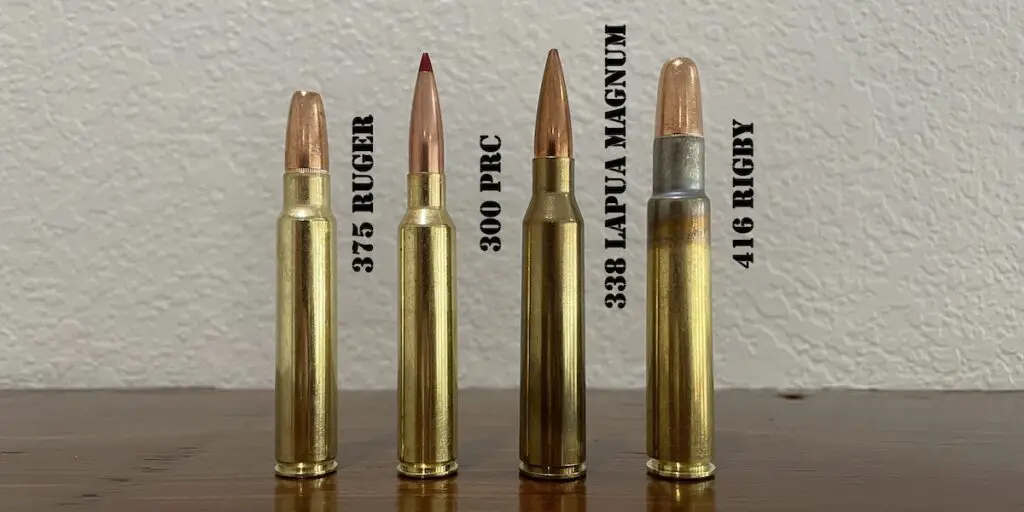
Head height is the amount of space available for the bullet outside the case while staying within SAAMI specifications for the cartridge. Basically, a cartridge with more head height can use very long, aerodynamic bullets without requiring them to be seated so deeply into the case that they intrude into the powder column and without having them stick out of the case so far they exceed the maximum SAAMI overall length for the cartridge.
Next, both cartridges have larger rim diameters and require a larger bolt face: the 300 PRC has a .532″ rim diameter and the 338 Lapua has a .588″ rim diameter.
Both cartridges use beltless cases, though the 338 Lapua has a larger diameter .587″ case at the base vs .532″ for the 300 PRC.
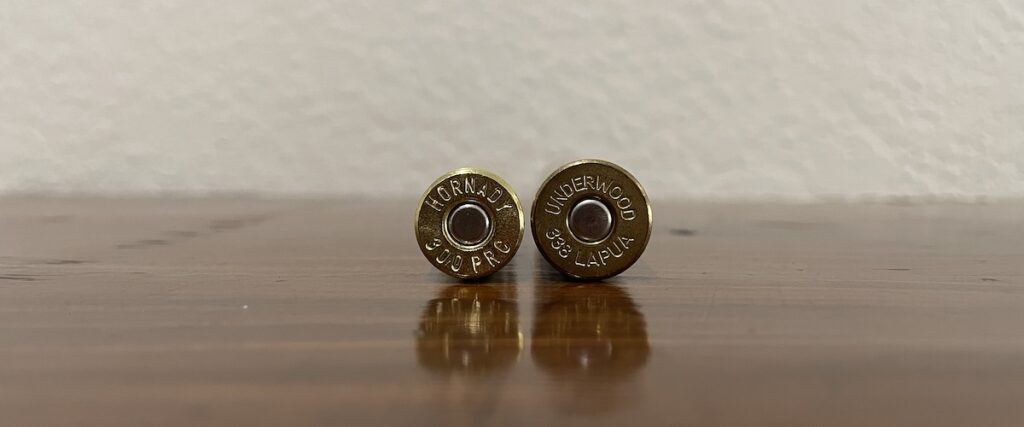
Additionally, the 338 Lapua Magnum has a 20 degree shoulder while the 300 PRC has a steeper 30 degree shoulder angle.
Though the 300 PRC is no slouch in this area, the 338 Lapua Magnum uses a cavernous brass case that can hold a gigantic amount of powder (load recipes that call for over 95gr or even over 100gr of powder are not uncommon for the 338 Lapua).
All told, the 338 Lapua can hold about 22% more powder than the 300 PRC as a result of its larger diameter and longer case.
Bullet weight and bullet diameter are two other important differences between the 300 PRC vs 338 Lapua.
First, the 300 PRC uses .308″ bullets while the 338 Lapua uses larger diameter .338″ bullets.
The 300 PRC normally uses bullets in the 190-250 grain range, with 190 grain bullets, 212 grain bullets, and 225 grain bullets being most common.
On the other hand, 338 Lapua factory loads typically use bullets in the 210-300 grain range. 250 grain and 300 grain loads are the most common for this round.
We’ll discuss the impacts of these differences in bullet weight and bullet diameter in more detail later in this article.
Finally, both the 300 PRC and 338 Lapua are loaded to the same SAAMI maximum average pressure of 65,000psi.
Note: while the powder capacity figures listed below do give a good indication of the differences between the two cartridges, exact case capacities vary slightly according to the brand of brass used.
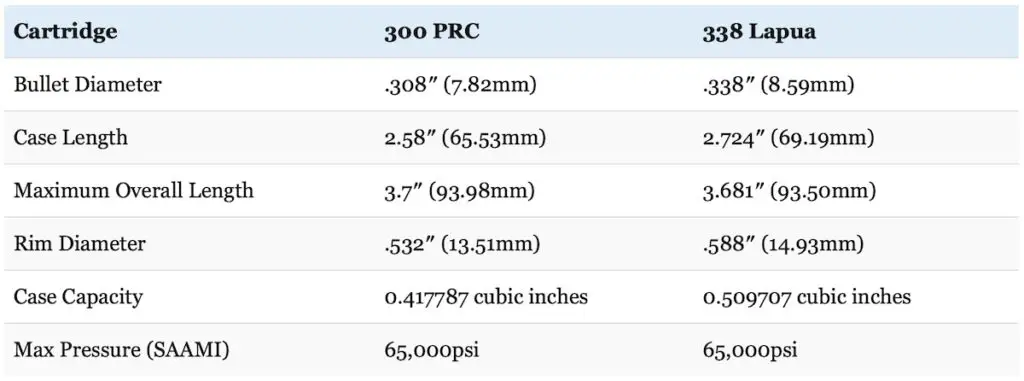
338 Lapua Mag vs 300 PRC Ballistics
As you might guess, the differences in the external dimensions of the 300 PRC and 338 Lapua cartridges also translate into some very interesting differences (as well as some somewhat surprising similarities) in their ballistic performance.
This is illustrated in the table below comparing Barnes VOR-TX and Hornady Precision Hunter factory loads for both cartridges. I chose those particular loads because they’re some of the only factory loads available for each cartridge designed for hunting that also use the exact same bullet type.
The 300 Precision Rifle Cartridge loads use 208gr LRX (.633 BC) and 212gr ELD-X (.663 BC) bullets.
The .338 Lapua Magnum loads use 280gr LRX (.667 BC) and 270gr ELD-X (.757 BC) bullets.
Note: the LRX is a lead free monolithic projectile designed by Barnes to deliver high weight retention and deep penetration. However, those bullets do not have as high of a BC as the ELD-X (though the LRX bullets still have pretty good BCs).
Additionally, while the ELD-X is designed to expand at velocities as low as 1,600fps, the LRX requires different minimum impact velocities. According to Barnes customer service, the 280gr LRX from the 338 Lapua requires a minimum impact velocity of 1,500fps for 1.7x expansion and 1,700 for 2x expansion while the 208gr LRX requires at least 1,700fps for 1.7x expansion and 1,900fps for 2x expansion.
I’m not certain why those bullets have different minimum impact velocities, but that’s what they told me when I called them.
Finally, I want to point out that the various bullets used in those 338 Lapua loads all have a higher BC than those used in the comparable .300 PRC loads.
All four loads use a 200 yard zero.
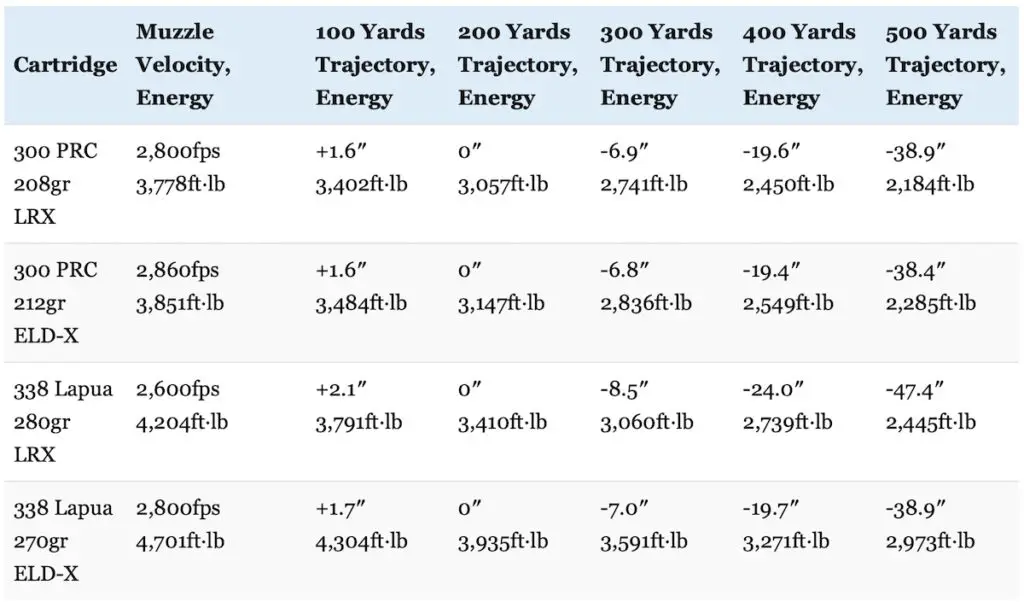
As you can see, the 300 PRC is actually a little bit flatter shooting than the 338 Lapua. That said, there’s not a large difference in the trajectory of the two cartridges.
Indeed, the two 300 PRC loads have virtually the same velocity as each other as well as the 270gr ELD-X load for the 338 Lapua.
Just 1/2 inch separates the 212gr 300 PRC load from the 270gr 338 Lapua load at 500 yards. This isn’t that surprising though when you consider the two 300 PRC loads and the 270gr 338 Lapua load all have virtually the same muzzle velocity and very similar BCs.
The 280gr Lapua starts out going around 200fps slower than the other three loads though. Combine this with a nearly identical BC as the other loadings and you get a more arching trajectory with about 9″ more bullet drop at 500 yards than everything else.
However, all four of these loads (but especially everything but the Barnes 338 Lapua load) are pretty darn flat shooting and only require 7-7.5 MOA of elevation adjustment to hit a target at 500 yards with a 200 yard zero.
That said, the 338 Lapua Magnum has quite a bit more muzzle energy than the 300 PRC. Depending on the exact loads compared, this advantage varies from a 9% to a 24% advantage in favor of the 338 Lapua.
Results are mixed as we go downrange: the 338 Lapua’s advantage in kinetic energy will grow when comparing like bullets to each other, but the 300 PRC will narrow the gap in retained energy when comparing the 212gr ELD-X to the lower BC 280gr LRX for the 338 Lapua.
Let’s not get too bogged down in the details though. After all, both cartridges are still carrying literally over A TON of kinetic energy out past 500 yards. Heck, that 270gr ELD-X load for the 338 Lapua still has nearly 3,000ft-lbs of energy remaining at that range!
To give you an idea of just how powerful these cartridges are, both 300 PRC loads have more retained kinetic energy at 400 yards than the 6.5 Creedmoor does at the muzzle! And both 338 Lapua loads are still carrying more energy than the 6.5 Creedmoor out past 500 yards!
Here’s how each 300 PRC load compares individually to the comparable 338 Lapua Magnum load in terms of muzzle energy, retained energy at 500 yards, and bullet drop at 500 yards:
Barnes: the 338 Lapua has 11.3% more muzzle energy, 11.9% more kinetic energy at 500 yards, and 8.5″ (21.9%) more bullet drop at 500 yards.
Hornady Precision Hunter: the 338 Lapua has 22.1% more muzzle energy, 30.1% more kinetic energy at 500 yards, and .5″ (1.3%) more bullet drop at 500 yards.
So, the big takeaways so far are the two cartridges have almost identical trajectories (though the 300 PRC is a little bit a flatter shooting cartridge), but the 338 Lapua is harder hitting up close and this advantage in retained energy grows as ranges increase.
Those trends continue as we look out to even longer ranges. Note that I’m not advocating using either cartridge for hunting at extreme range, but things start to get pretty interesting as ranges increase.
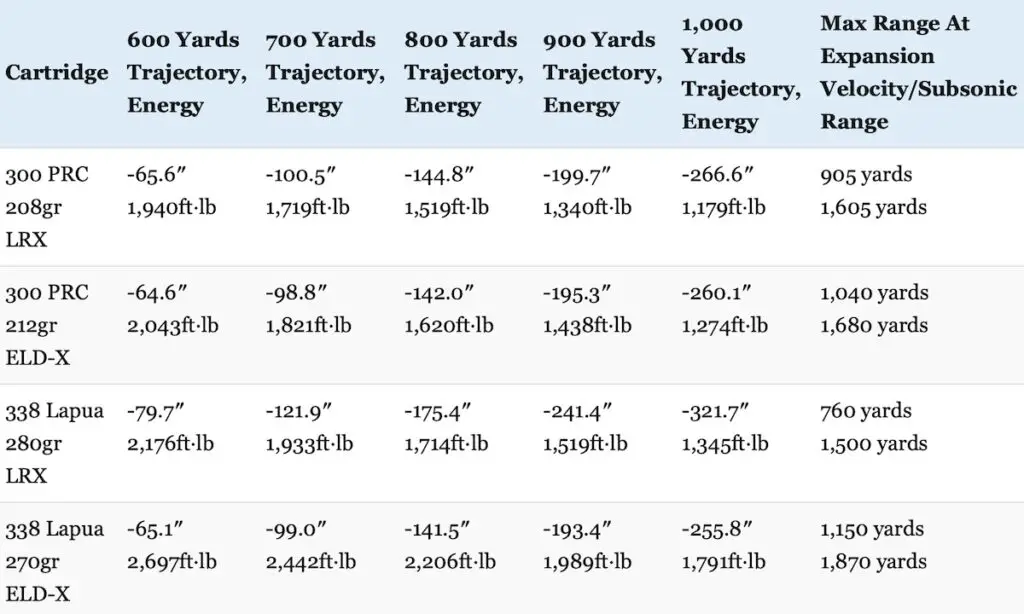
As you can see, the ridiculously high BC 270gr 338 Lapua loading surpasses the 208gr LRX by 600 yards and the 212gr ELD-X just past 700 yards in the trajectory department.
That particular load has the least bullet drop at 1,000 yards out of every load compared here.
All the 338 Lapua loadings continue to have more kinetic energy than the comparable 300 PRC loads in terms of retained kinetic energy as well.
In that vein, the 280gr LRX drops below the 6.5 Creedmoor’s muzzle energy of 2,315ft-lbs around 550 yards and the 270gr ELD-X stays above that threshold until it travels a staggering 750 yards downrange!
Like I keep saying: the 338 Lapua Magnum is a beast of a cartridge that starts off with over two tons of kinetic energy and then hangs onto that energy exceptionally well (both loads carry more than 1,500ft-lbs of energy out past 900 yards) because it uses such aerodynamic bullets.
Even so, though the 338 Lapua is unquestionably more powerful, the 300 PRC still performs really well in this area.
Both 300 PRC loads carry over 1,500 ft-lbs of kinetic energy out past 800 yards and over 1,000 ft-lbs of energy out past 1,000 yards.
The 212gr ELD-X in particular doesn’t dip below its minimum recommended impact velocity until over 1,000 yards and stays supersonic until it travels nearly a mile downrange!
Now let’s talk about another important factor: wind.
The chart below compares how much a 10 mile per hour crosswind impacts those same 300 PRC and 338 Lapua loads out to 500 yards.
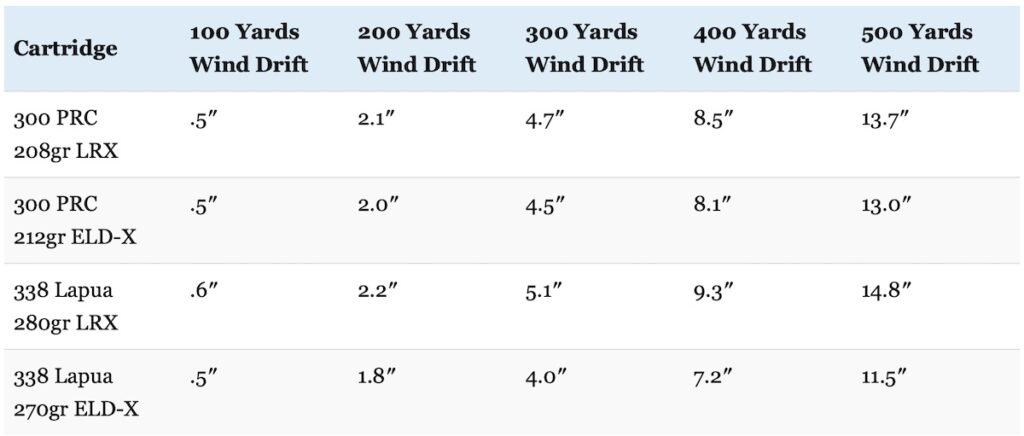
Both cartridges perform well here too, but this is an area where the 338 Lapua can really excel with the right bullets.
The 338 Lapua ELD-X has the least wind deflection, followed by the 300 PRC 212gr ELD-X load, the 300 PRC Barnes LRX, and then finally the 280gr LRX for the 338 Lapua.
While all of these loads (but to a lesser extent with the 280gr LRX because of its slower muzzle velocity) have excellent wind bucking characteristics, I was incredibly impressed with how well the 338 Lapua performed here.
Having just under a foot of wind deflection at 500 yards with a 10 mph full value crosswind like the 270gr ELD-X is fantastic! Indeed, that 270gr ELD-X loading for the 338 Lapua delivers some of the best performance in windy conditions currently available for any factory big game hunting ammo right now.
That said, those two 300 PRC loads are right there with it though with just 1.5-2.2″ more wind deflection at 500 yards as well!
Those differences become even more apparent at longer range too.
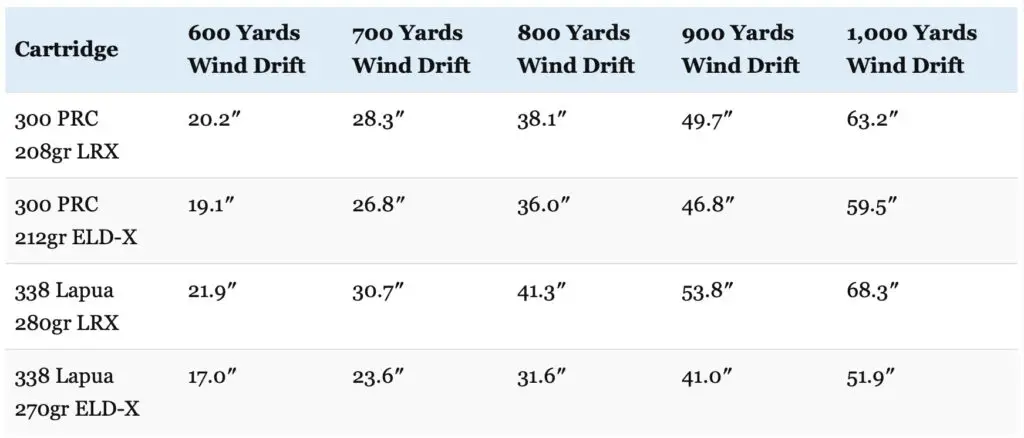
For instance, the advantage that 270gr ELD-X load has over the 300 PRC continues to grow as the range increases.
This is an area where both cartridges (but especially the 338 Lapua) really perform well with their pretty fast muzzle velocity and exceptionally high BC bullet (over a .600 BC is excellent for performance in the wind and over a .700 BC like the 270gr ELD-X is phenomenal).
Even though the 338 Lapua 280gr LRX load doesn’t appear to do that well in this area compared to the other three loads, it still has less wind deflection than many other high powered cartridges. For instance, it outperforms the 300 Win Mag in this area.
Now a flat trajectory can certainly simplify shot placement.
However, modern laser rangefinders combined with ballistic turrets for a rifle scope and/or ballistic calculator smartphone apps make calculating holdover much more simple than was the case just a few years ago.
Determining an appropriate wind hold is much more challenging though.
This is where a cartridge like the 338 Lapua or 300 PRC has a real advantage because they use high BC bullets that resist wind deflection exceptionally well are more forgiving of wind direction and/or wind speed estimation errors.
Why is this the case?
Assuming the same wind conditions, wind deflection is dependent on bullet velocity and BC. However, small changes in ballistic coefficient result in bigger changes in wind deflection than is the case with velocity.
For this reason, the 338 Lapua load firing the insanely high BC 270gr ELD-X at a pretty darn fast muzzle velocity comes out on top here with the 212gr ELD-X from the 300 PRC a close second.
External ballistics don’t tell the whole story though and there’s more to picking a hunting cartridge than kinetic energy, bullet drop, or wind drift at various ranges.
For instance, now let’s talk about recoil.
The table below compares the recoil produced by handloads that are very similar to the 212gr and 270gr loads for the 300 PRC and 338 Lapua respectively when fired from 10 pound rifles.
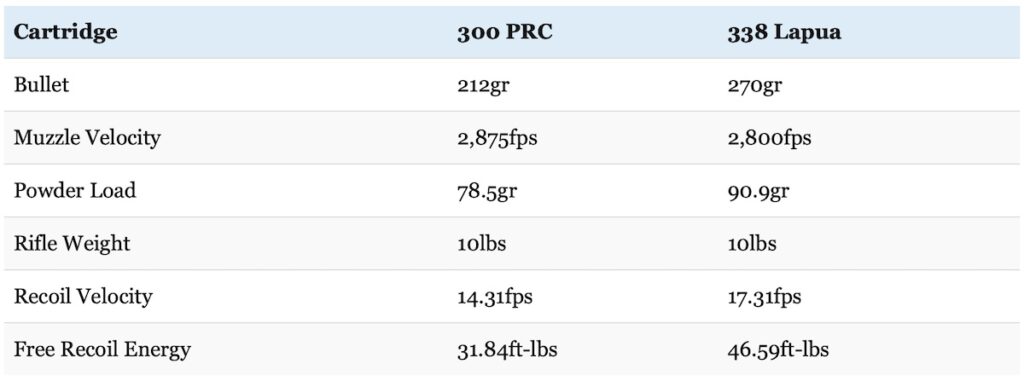
As you can see, the both the 300 PRC and 338 Lapua have fairly stout recoil, but the 338 Lapua has a lot more recoil than the 300 PRC.
This is because the 338 Lapua fires a much heavier bullet and uses significantly more powder to achieve that performance. For this reason, the 338 Lapua Magnum has about 46% more free recoil energy than the 300 PRC.
The 300 PRC isn’t what I’d call a light kicking round either!
The 300 PRC is probably right at the upper end of what most shooters can handle in terms of recoil when shooting a rifle that fits them well, that has a good recoil pad, or is equipped with a muzzle brake or suppressor.
The 338 Lapua? Well, some people can handle it better than others.
And remember: those recoil figures are calculated with a 10 pound rifle and will increase for shooters using lighter rifles.
I actually knew a guy who was considering building an ultra-lightweight rifle (6-7 pounds fully loaded) chambered in 338 Lapua. I did eventually talk him out of doing so when I told him he’d be dealing with 458 Win Mag level recoil (around 66-67 ft-lbs of free recoil energy) out of a rifle that light!
For reference, typical factory loads for the 6.5 Creedmoor, 300 Win Mag, and 375 H&H generate around 11 ft-lbs, 26ft-lbs, and 39ft-lbs of free recoil energy respectively when they’re all fired from 10 pound rifles.
So, the 300 PRC falls in between the 300 Win Mag and 375 H&H in the recoil department while the 338 Lapua has about 20% more free recoil energy than the 375 H&H.
Once could reasonably describe the 300 PRC recoil as “stout.” Depending on the shooter and the exact rifle set-up, one could describe 338 Lapua recoil as “tooth rattling” or even “savage” in extreme cases.
This is why 338 Lapua rifles often come with a muzzle brake. Those brakes do tend to do a good job of taming recoil, but they come at the expense of ferocious muzzle blast, especially to bystanders.
A good suppressor will tame recoil and muzzle blast to a large degree, but the 338 Lapua is still a handful and even the toughest of shooters may feel the effects of an extended session at the range with a 338 Lapua afterwards!
Do not underestimate this factor. It doesn’t matter how great the performance of the 338 Lapua is on paper if the shooter is too scared of their rifle’s recoil and develops a flinch!
Additionally, there are a couple of other factors that are also worth discussing.
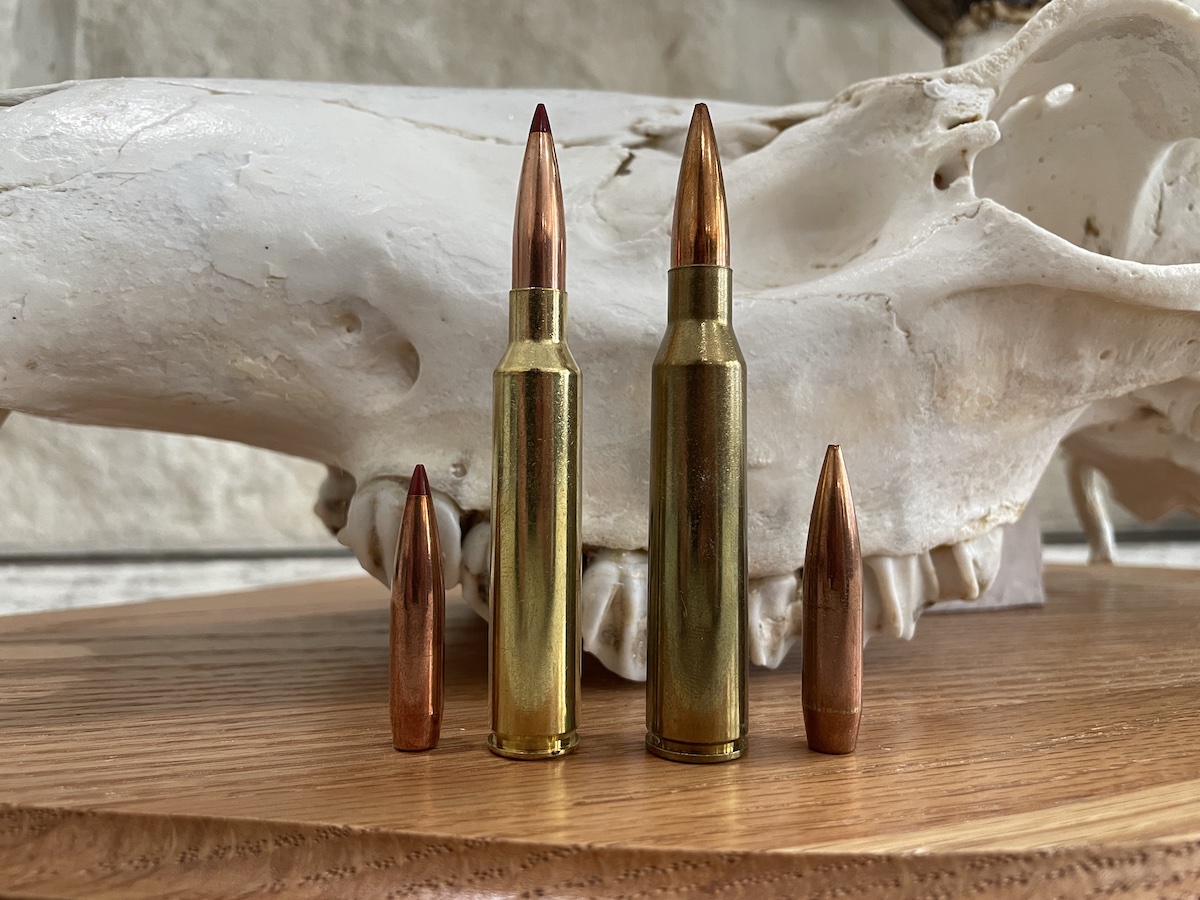
First, the 338 Lapua uses larger diameter bullets than the 300 PRC .
Specifically, the larger diameter .338″ bullets it uses have about 20% more frontal surface area (also known as cross sectional area) than the .308″ bullets used by the 300 PRC (.0897 vs .0745 square inches). All other things being equal, a bigger bullet will make a bigger hole, cause more tissue damage, and result in more blood loss.
This is a significant advantage in favor of the 338 Lapua Magnum and, especially when combined with the cartridge’s great retained kinetic energy, those larger diameter bullets can certainly also be helpful on bigger and/or tougher game.
Additionally, the 338 Lapua Magnum has an edge over the 300 Precision Rifle Cartridge in terms of bullet sectional density (SD) in most cases.
Sectional density (SD) is a measure of the ratio of the diameter of a projectile to its mass. All other things equal, a heavier projectile of a given caliber will be longer and therefore have a higher sectional density and consequently penetrate deeper than projectiles with a lower mass and sectional density.
225 grain, 250 grain, 270 grain, and 300 grain .338″ bullets have sectional densities of .281, .313, .338, and .375.
190 grain, 200gr, 212gr, and 225gr .308″ bullets have sectional densities of .286, .301, .319, and .339 respectively.
So, .338 Lapua bullets have a small edge over 300 PRC bullets when comparing the heaviest bullets available for each cartridge, but the 300 PRC still performs pretty well in this area as well.
I think it would be fair to say that overall the 338 Lapua is still a heavier hitter, but the 300 PRC punches well above its weight in terms of terminal performance.
This is because the 300 PRC is a more efficient cartridge that can fling a very high BC bullet at an impressive velocity without requiring nearly as much powder (or generating as much recoil) as the 338 Lapua. The end result is a cartridge that brings more than enough of the good attributes hunters like in a cartridge without as many of the downsides of the 338 Lapua.
At the same time, the 300 PRC offers some undeniable advantages in trajectory and recoil that can assist the shooter in shot placement.
Speaking of shot placement, that brings me to my next point.
338 Lapua vs 300 PRC Accuracy
What about 300 PRC vs 338 Lapua Magnum accuracy?
While external ballistics are extremely important, performance on paper doesn’t mean a darn thing if you can’t hit your target.
John Snow wrote a fantastic article on this exact subject for Outdoor Life and I strongly advise you to check it out.
Long story short though, companies designing new cartridges these days (especially Hornady) typically employ more modern cartridge design principles that incorporate best practices competition and benchrest shooters have refined over the years to obtain the best possible accuracy.
Cartridges designed using these principles are typically employ minimal body taper, headspace off sharp shoulders, are designed for use with rifles that have faster twist rates to stabilize heavy, high BC bullets, have cases with a long enough neck to support those longer, high BC bullets, can seat those long, high BC bullets to the SAAMI specified maximum overall length without intruding into the powder column, and have a chamber design with a snug throat.
Taken together, these design principles result in cartridges with a very high degree of accuracy potential, especially at extended range.
Like I mentioned earlier, the 300 PRC design incorporates all of those principles.
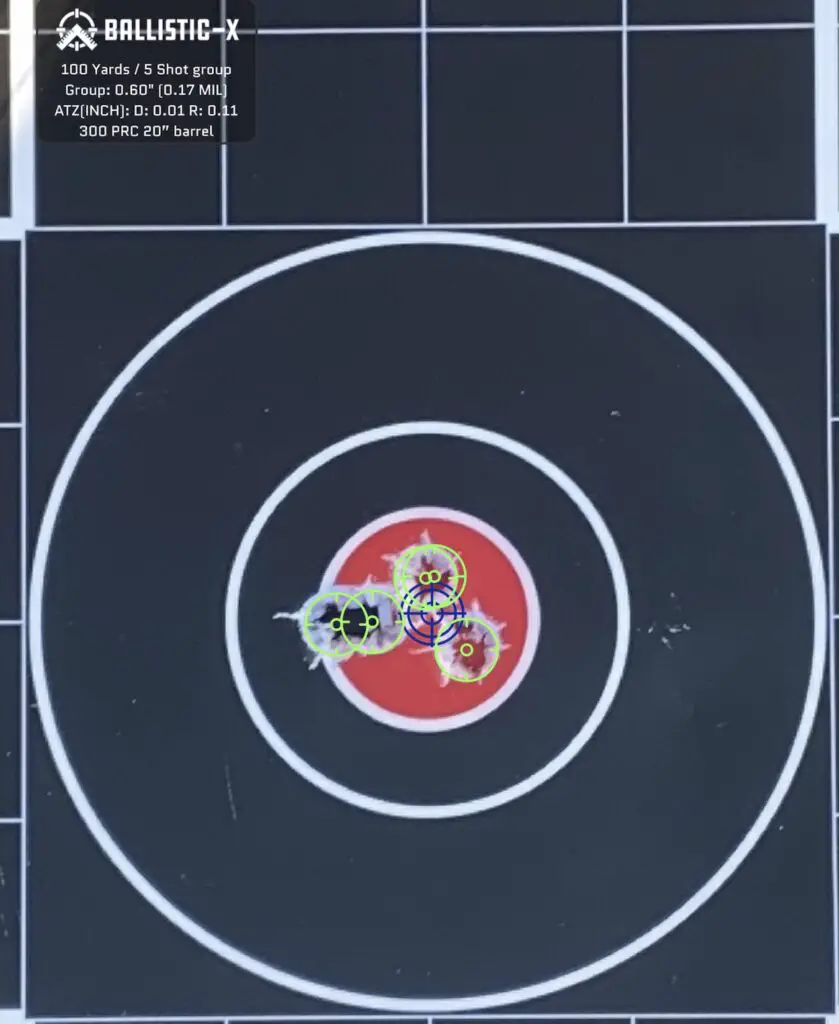
Let’s explore these things in more detail.
First, the throat is the smooth portion of a rifle barrel closest to the cartridge. Having a more snug throat diameter means there’s less room for the bullet to yaw upon firing before engaging the rifling, which can help enhance accuracy.
Well, the 300 PRC and 338 Lapua both have a throat diameter just .0008″ larger than the bullet diameter.
That is a very “snug” throat diameter compared to older cartridges like the 243 Winchester (.0033″) or .30-06 (.0026″).
Call it a wash for the two cartridges in this specific area.
However, the 300 PRC utilizes a case with less body taper and steeper 30 degree shoulder. Both of these characteristics result in better cartridge alignment in the chamber and more consistent headspacing.
The 300 PRC also has a faster SAAMI spec rifling twist of 1:8.5″ (the 338 Lapua has a 1:10″ standard twist rate) and the 300 PRC also has more head height.
Relative to the caliber of the bullets each cartridge shoots, the 300 PRC also has a longer case neck.
All of those things facilitate use with those long, heavy, high BC bullets I keep talking about.
Taken together, all of these individual factors result in excellent accuracy potential for the 300 PRC, especially with long, heavy, high BC bullets.
Which one is better?
Both are capable of excellent accuracy, but I give a small advantage to the 300 PRC here.
That’s not to say the 338 Lapua isn’t capable of great accuracy, but I’d say that on average, the 300 PRC has better accuracy potential with factory rifles and ammunition.
Details will vary on the exact rifle, ammunition, and shooter in question though and yes, there will be instances of 338 Lapua rifles shooting more accurately than 300 PRC rifles.
So where do we stand overall?
300 PRC vs 338 Lapua Mag
The 338 Lapua fires larger diameter and heavier bullets that usually have a higher BC at nearly the same velocity as the 300 PRC. The 338 Lapua has more recoil, better resistance to wind deflection, and more kinetic energy at all ranges, but the 300 PRC is still a powerful cartridge itself and often has a flatter trajectory.
338 Lapua vs 300 PRC Ammo
Both the 338 Lapua Magnum and 300 PRC are somewhat specialized cartridges designed for specific niches in the hunting and shooting communities. For this reason, neither is extremely popular and options for both 338 Lapua and 300 PRC ammo are limited.
Don’t get me wrong: ammunition for these cartridges is not rare by any stretch of the imagination (at least they’re not rare now that the worst of the ammo shortage seems like it’s behind us), but there also just aren’t nearly as many offerings for each one as is the case with more mainstream chamberings like the 6.5 Creedmoor, 308 Winchester, 30-06 Springfield, etc.
For example, MidwayUSA currently lists 25 338 Lapua Magnum loads and 8 300 PRC loads on their web site as I write this article.
Some manufacturers offer ammunition for both cartridges and sometimes even offer them in the same ammo lines.
Likewise, though there are both hunting and match ammo options available for both, there seems to be a larger variety of 300 PRC hunting ammo than match ammo while 338 Lapua factory ammo seems to be closer to a 50/50 split between hunting and match applications.
For instance, Hornady offers 300 PRC and 338 Lapua ammunition in their Precision Hunter and Match lines with 212gr ELD-X, 270gr ELD-X, 225gr ELD Match, and 285gr ELD Match bullets respectively.
They also offer ammunition for both cartridges with their CX bullet: the 300 PRC in their Outfitter line with a 190gr CX bullet and the 338 Lapua in their Custom line with a 240gr CX bullet.
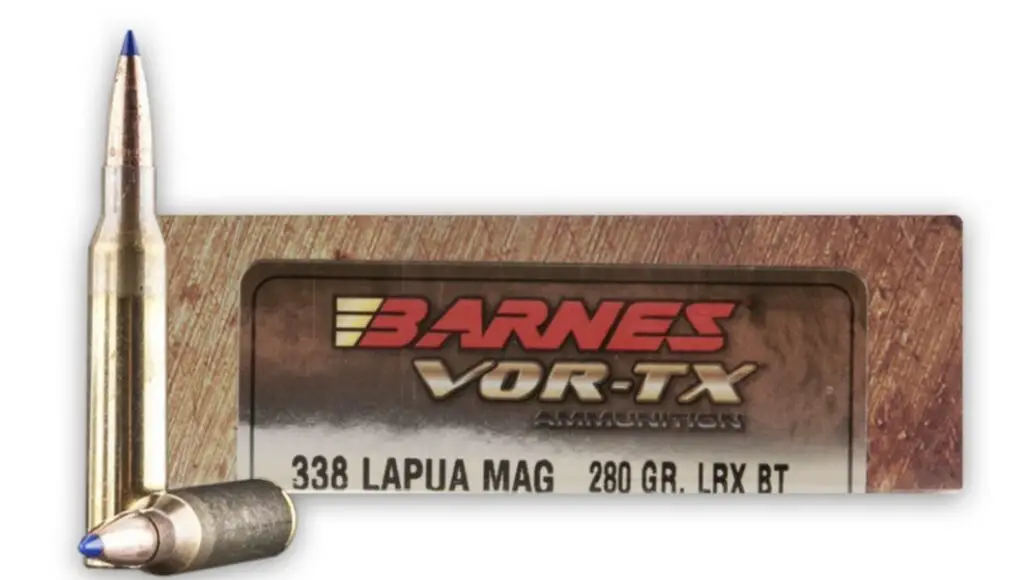
Barnes is another notable example of a company that offers 300 PRC and 338 Lapua ammunition and they produce a 300 PRC load with a 208gr LRX and a 338 Lapua load with a 280gr LRX. Barnes also offers the 338 Lapua in their Precision Match line with a 300gr Match Burner.
Other companies only produce ammunition for one cartridge or the other or offers ammunition for both, but in different ammunition lines intended for different use cases.
Of note, Federal Premium offers the 300 PRC in their Terminal Ascent hunting lineup with a 210gr Terminal Ascent bullet and produces 338 Lapua ammo in their Gold Medal line with 250gr and 300gr Sierra MatchKing bullets.
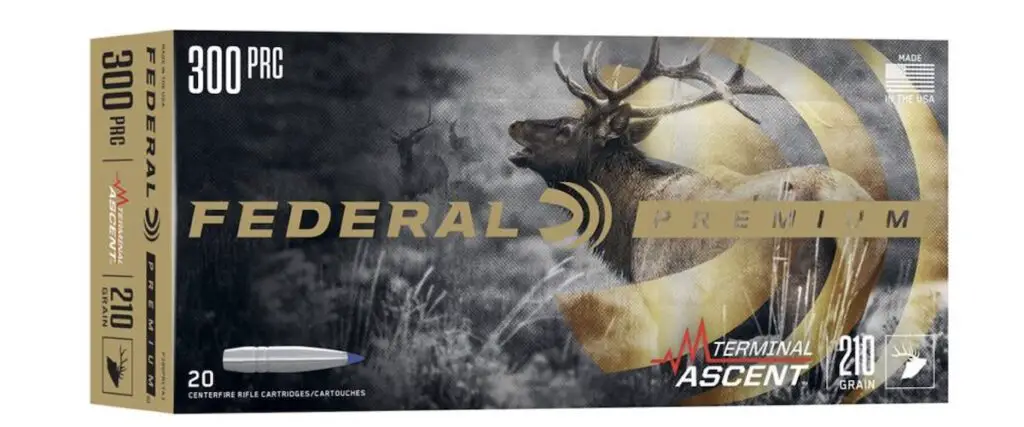
Berger also makes ammunition for both cartridges: 205gr and 245gr loads for the 300 PRC in their Elite Hunter line along with 250gr Elite Hunter, 300gr Elite Hunter, and 300gr Hybrid OTM Tactical Rifle loads for the 338 Lapua Magnum.
Remington does not currently manufacture 338 Lapua ammunition, but does produce 300 PRC ammunition in their Tipped Core Lokt and Premier Long Range hunting lines with 210gr Tipped Core Lokt and 215gr Speer Impact bullets respectively.
On the other hand, Winchester manufactures 338 Lapua, but not 300 PRC, ammunition and includes the 338 Lapua in their Winchester Match line with a 250gr Match BTHP and in the Expedition Big Game line with a 300gr AccuBond CT.
Swift also does not currently offer 300 PRC ammo, but they produce 338 Lapua factory loads using 210gr Scirocco and 250gr A-Frame bullets.
The same is also true with Nosler and they currently produce 338 Lapua ammo in their Trophy Grade line with a 300gr AccuBond and in their Match Grade line with a 300gr HPBT Custom Competition.
Finally, a few other companies like Black Hills, Sellier & Bellot, and of course Lapua Ammunition all produce 338 Lapua ammunition using various bullets like the Lapua Scenar and Sierra MatchKing.
With all that said, additional 300 PRC ammo prospects in the near future are looking better than is the case for the 338 Lapua and I wouldn’t be surprised to hear that other companies (like Nosler) will pick up the 300 PRC and start offering additional hunting ammo options for it here pretty soon.
Ammo is pretty expensive for both rifle cartridges.
The cheapest 338 Lapua ammo that I could find on the today cost about $4.40 per round (not including sales tax or shipping). 338 Lapua hunting ammo was in the $6-10 per round range.
Though it’s still not cheap by any stretch of the imagination, 300 PRC ammo is definitely less expensive than 338 Lapua ammo and I found multiple 300 PRC hunting and match ammo options in the $3-4.50 range.
If you’d like to learn more about some of the various hunting ammunition choices for the 300 PRC , read the article below:
Best 300 PRC Ammo For Hunting Elk, Deer, Bear, & Other Game
300 PRC vs 338 Lapua Magnum Rifles
The rifle situation with the 300 PRC and 338 Lapua Mag is actually a little different than the ammunition situation: rifles chambered in 300 PRC are more common than 338 Lapua rifles.
For example, Guns.com currently lists 86 300 PRC rifles and just 45 338 Lapua rifles as I type this article.
Likewise, Sportsman’s Warehouse lists 106 300 PRC rifles and only 37 338 Lapua rifles right now.
Both cartridges are almost exclusively available in bolt-action target and hunting rifles.
Certain models like the Ruger Precision Rifle, Barrett MRAD, Christensen Arms Mesa and Modern Precision Rifle (MPR), and Savage 110 are available in both cartridges.
A few manufacturers like FN and Armalite offer 338 Lapua, but not 300 PRC, rifles.
The 300 PRC is also available in some rifles that are not manufactured in 338 Lapua, like the Browning X-Bolt, Bergara B-14 HMR, Wilderness Ridge, Wilderness Terrain, and Premier Mountain 2.0, and the CVA Cascade.
The 300 PRC definitely seems to have the best selection of rifles right now. I also wouldn’t be surprised if that advantage for the 300 PRC continued to grow over the next 10 years.
Keep in mind that rifles in both 300 PRC and 338 Lapua tend to have longer barrels and weigh more than rifles in smaller cartridges. For instance, 26″ barrels (and sometimes even longer barrels) are very common for rifles in both cartridges.
It’s also important to realize that both cartridges are available in rifles specifically desigend for hunting as well as for long range precision shooting at the range. That said, rifles optimized for one of those use cases tend to be VERY different from those optimized for the other.
Additionally, the 300 PRC is more widely available in hunting rifles than the 338 Lapua.
Here are a few examples that illustrate these points.
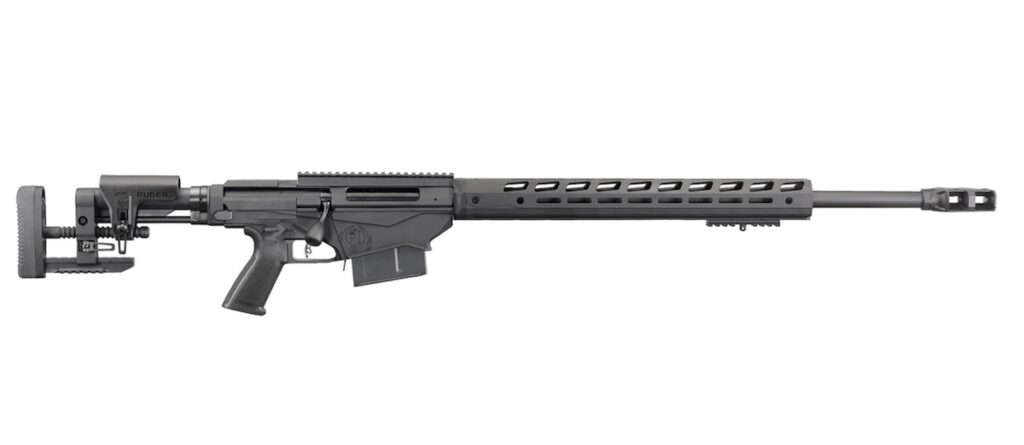
Ruger manufactures their Ruger Precision Rifle in both cartridges.
Both the 300 PRC and 338 Lapua variants have a 26″ barrel, an overall length up to 52.5″ long, and weigh 15.2 pounds.
Those are BIG and HEAVY rifles much better suited for use at the range than carrying afield on a hunt. To be fair though, Ruger specifically markets these rifles for long range shooting matches and competitions instead of for hunting (heck, it even says so in the rifle’s name).
Even so, the Ruger Precision Rifle is a good example of the sort of rifles commonly available in both cartridges. Those sorts of rifles would be terrible for carrying up a mountain on an elk hunt, but just about perfect for banging steel or punching paper at ranges out past 1,000 yards or even a mile.
But what about someone who wanted to hunt with a 300 PRC vs 338 Lapua?
Well, Savage Arms makes variants of the Savage 110 Long Range hunter in both cartridges.

Both versions of the rifle have a 26″ barrel, an overall length of 49.5″, and weigh 8.85 pounds.
The biggest differences between the version in 300 PRC (pictured above) and the version in 338 Lapua (below) are that the 300 PRC has a removable muzzle brake and a hinged floorplate magazine while the 338 Lapua version has a detachable box magazine and a fixed muzzle brake.

Though both rifles are still physically pretty large and heavy, both are much better suited for taking afield hunting than is the case with rifles like the Barrett MRAD or Ruger Precision Rifle.
As you can see, the muzzle brake on the 338 Lapua version of the Savage 110 is much larger and more aggressive than the one used on the 300 PRC 110 rifle (make darn sure you wear ear protection while hunting with one of those rifles). This is likely due to the fact that the 338 Lapua simply has a lot more recoil than the 300 PRC.
The Savage 110 rifle in 338 Lapua also uses a fixed muzzle brake while the one in 300 PRC is removable. This may also be a reflection of the fact that 30 caliber suppressors are much more common than .338 caliber suppressors.
There are certainly several options for 338 cal suppressors available, but they’re just not as common, tend to be larger and heavier, and are usually more expensive than 30 caliber suppressors.
For what it’s worth, I think the Banish 30 Gold is an ideal 300 PRC suppressor while the Banish 338 is an ideal 338 Lapua suppressor.
Anyway, just keep in mind the fact that you’ll just simply have more hunting rifle options for the 300 PRC (to include several other models from Bergara, Browning, and Christensen Arms) if you’re looking for a heavy hitting cartridge with good long range performance that’s more suitable for packing for many miles in the backcountry.
Rifles in both cartridges tend to be pretty expensive as well. The Savage models are the least expensive, but still run over $1,000 and prices only go up from there with options like the Ruger Precision Rifle, Barrett MRAD, and models from Christensen Arms and Accuracy International.
300 PRC vs 338 Lapua Mag: Which Is Right For You?
Do you primarily hunt medium sized game like whitetail deer, pronghorn, feral hogs, or black bear at ranges within 200 yards? Both are extremely effective cartridges for hunting game that size. There really isn’t a significant difference between the 300 PRC and 338 Lapua on deer-sized game inside of 200 yards and both are more than powerful enough for that sort of work.
In fact, I’d say you need to work on your shooting or switch to a cartridge with less recoil than these two rounds if you’re having problems cleanly killing deer sized game with either one inside 200 yards!
In all seriousness though, while both the 300 PRC and 338 Lapua were originally designed for work at extreme range, both have also developed a great reputation for hitting game like an absolute sledgehammer at shorter distances.
For example, Cameron Mitchell shot the two deer in the video below with a 300 PRC using 212gr Hornady ELD-X bullets. Both shots were inside 300 yards: the doe dropped instantly at the shot and the buck went less than 50 yards afterwards (even with a hit that looked like it was a little far back).
It’s always nice when you cleanly and quickly take game, but this sort of performance is more important in some situations than others.
For instance, nilgai are a species of antelope originally from India that now inhabit large portions of south Texas. Those creatures are renowned for their toughness.
This fact, combined with the thick brush of that part of Texas, means they can be extremely difficult to track if they go more than a short distance after the shot.
Plenty of hunters cleanly kill nilgai using smaller cartridges and I’m not going to say you need a cannon to hunt one. However, some nilgai outfitters recommend hunters use powerful cartridges .338 caliber or larger on nilgai in order to anchor them in place.
Well, the 338 Lapua fits the bill perfectly here and you can see what I mean in the video below of Keith Warren shooting a bull with his 338 Lapua.
I think the results speak for themselves there.
Yes, you can certainly kill a nilgai with a smaller round (and even drop them in place like that at times too).
However, this is a great example of how a larger bullet from a more powerful cartridge in the right spot can be more effective than a smaller bullet from a less powerful cartridge that’s identically placed.
On another note, did you notice how careful Keith had to be when maneuvering his rifle into position for his shot?
Keep that fact in mind if you’re going to be hunting in thicker brush or a box blind like he was. 338 Lapua (and 300 PRC) rifles often have very long barrels that can be a real headache to deal with when trying to quickly and quietly maneuver for a shot.
To be perfectly candid with you, I wouldn’t recommend either cartridge for someone looking for a rifle ideally suited for hunting in conditions like that. Taking a 300 PRC or 338 Lapua rifle with a 26″ barrel on a hunt where you’ll be in a small box blind every now and then is one thing.
Doing that sort of hunting almost exclusively is something else and you stand a darn good chance of unintentionally banging your rifle barrel into the ceiling or the wall and potentially scaring off your quarry with a barrel that long.
The 300 PRC and 338 Lapua both excel in more open country though. The same is true for shooting across a big field or down a long power line or firebreak.
To that end, are you looking for the cartridge better suited for long range hunting for game like whitetail deer, mule deer, black bear, or pronghorn antelope in open country where you might need to take a shot at several hundred yards? Both the 300 PRC and 338 Lapua are great in this role and situations like these are where they start to stand apart from other cartridges.
The 338 Lapua has the advantage in this area terms of having better performance in the wind and carrying more energy out at extra long range, but the 300 PRC is excellent as well.
Truth be told, I don’t think there’s any need to bump up to a 338 Lapua unless you just want to because the 300 PRC is more than powerful enough to cleanly take deer as far as you’d reasonably be shooting one.
That video is also a good example of how a smaller framed shooter can handle 300 PRC recoil under the right conditions. From the looks of it, he was using a Bergara Wilderness HMR. The 300 PRC version of that rifle weighs 9.9 pounds from the factory.
Adding a scope, rail, sling, full magazine, etc. bumps that weight up to 11.5-12 pounds. A heavy rifle like that won’t be fun to carry, but it will really dampen recoil.
Similar deal with the muzzle brake: that rifle sounded almost like a cannon going off, but it will further reduce perceived recoil.
How about using these cartridges on bigger game? Like caribou, moose, elk, eland, kudu, or red stag hunting? Again, both will work extremely well when used on bigger game in North America, Africa, Europe, and elsewhere.
For instance, Ryan Cleckner shot this elk with his 300 PRC using a Hornady 212gr ELD-X. If I recall correctly, the range wasn’t extremely long (under 300 yards) and he shot it twice. The first shot staggered the elk, then the bull swapped ends, so Ryan shot it again in the other shoulder. The elk collapsed very close to where he was originally standing shortly after the second shot.
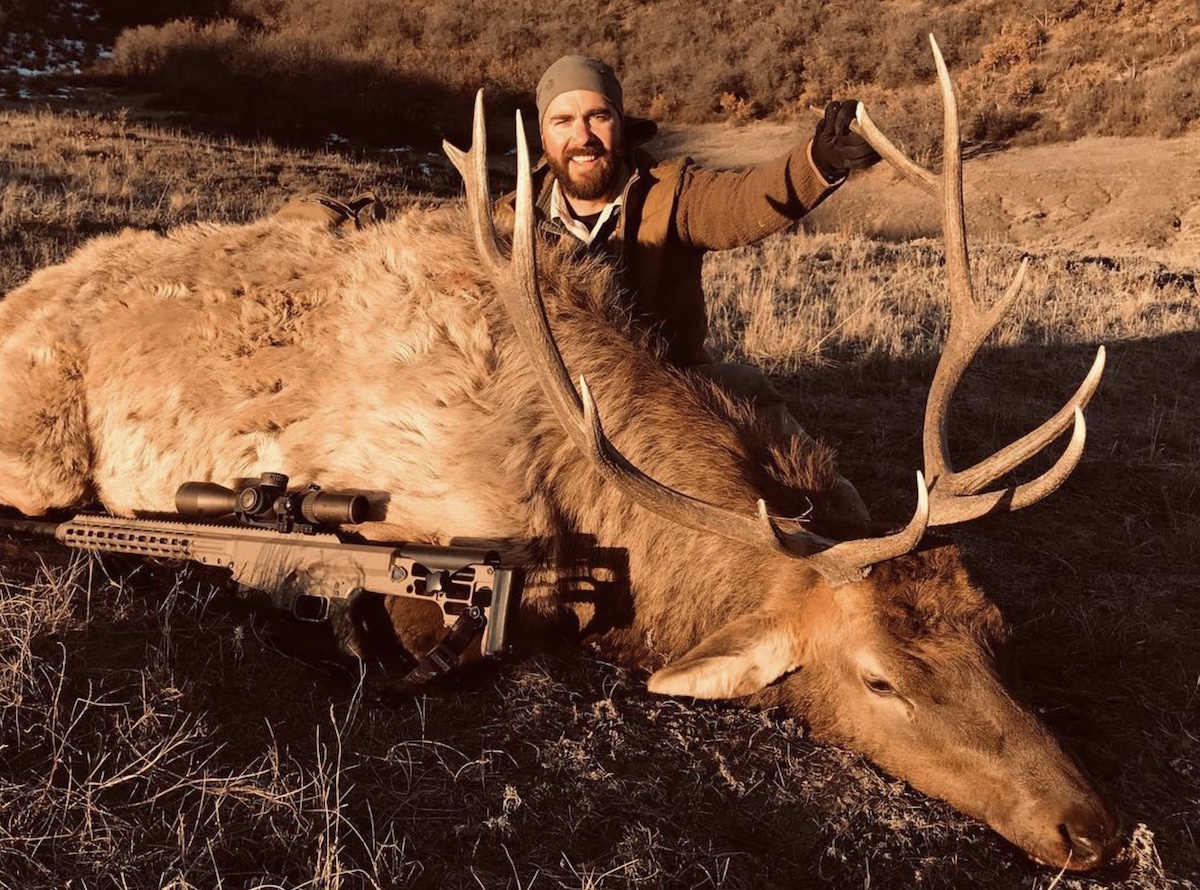
Results like that on an elk inside 300 yards are great, but how about elk hunting with the 300 PRC at extended range?
Well, this gentleman shot an elk cow at 830 yards with his 300 PRC using a 225gr ELD Match bullet.
That elk collapsed like a ton of bricks after taking a high shoulder shot from a 225gr ELD Match. I don’t love that particular bullet for hunting, but it clearly did the job in this case.
As capable as the 300 PRC can be on bigger game at long range, the 338 Lapua certainly has advantages for this use case too.
In addition to the fact that most 338 Lapua hunting loads retain more energy at extended range, the cartridge also has better resistance to wind across the board.
Since windy conditions tend to be pretty common out west, wind resistance for a cartridge should not be overlooked. I wouldn’t blame someone for choosing the 300 PRC, but the strengths of the 338 Lapua cannot be denied for someone that wants as heavy hitting of a round as possible at longer range on bigger game.
This is especially true in situations where you absolutely cannot get closer and have to choose between either taking a shot at longer range or going home empty handed.
That’s the situation this hunter was in when he spotted a moose in Alaska and made a couple of shots out past 900 yards that were both right on the money.
To be fair though, I think the 300 PRC would have also worked great in that situation and identical shot placement with something like a 212gr ELD-X likely would have had similar results from a cartridge with less recoil.
Are you specifically hunting brown or grizzly bear? What if you hunt in Canada or Alaska and need a heavy hitting cartridge just in case you find yourself on the wrong end of a grizzly/brown bear attack? As long as you’re not hunting with a guide who has a .375 caliber minimum, both the 300 PRC and 338 Lapua will work darn well on the big bears.
Though the 338 Lapua would seem like the better choice in this role since it’s more powerful and uses larger diameter and heavier bullets, you could also make a very compelling argument for the 300 PRC here too.
Regardless of which way you go, use premium bullets (like that Barnes LRX I mentioned earlier). Or you could go with a custom handload using something like a 220gr Nosler Partition like the gentleman in the video below did on his Kodiak Island brown bear hunt (be careful: there are some swear words at the very end).
Once again, the 338 Lapua probably would have delivered very similar results with identical shot placement. Would it have killed that bear any faster?
I doubt that bear could have expired much faster than it did after taking a couple of hits from a 300 PRC like that.
What about other species of dangerous game like cape buffalo?
To be clear: I do not advocate using either cartridge for hunting cape buffalo. For one thing, .308 caliber and .338 caliber cartridges are not legal in some African countries that have a .375 caliber minimum for hunting thick skinned dangerous game like buffalo.
That said, the 338 Lapua is the better choice out of these two cartridges. In fact, Brandon Maddox of Silencer Central used a 338 Lapua Magnum shooting 270gr ELD-X bullets to cleanly kill a cape buffalo in 2023.
The ELD-X is a lot softer than what I’d like for buffalo, but this is somewhat offset by the fact that it has a very high sectional density of .338 (well in excess of the .300 normally recommended for thick skinned dangerous game) and because that particular load’s 4,700 ft-lbs of muzzle energy exceeds that of noted dangerous game cartridges like the 375 H&H and 416 Rigby.
I still don’t recommend hunting cape buffalo with a 338 Lapua or 300 PRC, but this is proof that it’s possible to kill a buffalo with one and I’d steer hunters towards the 338 Lapua if they insist upon using one of these two cartridges.
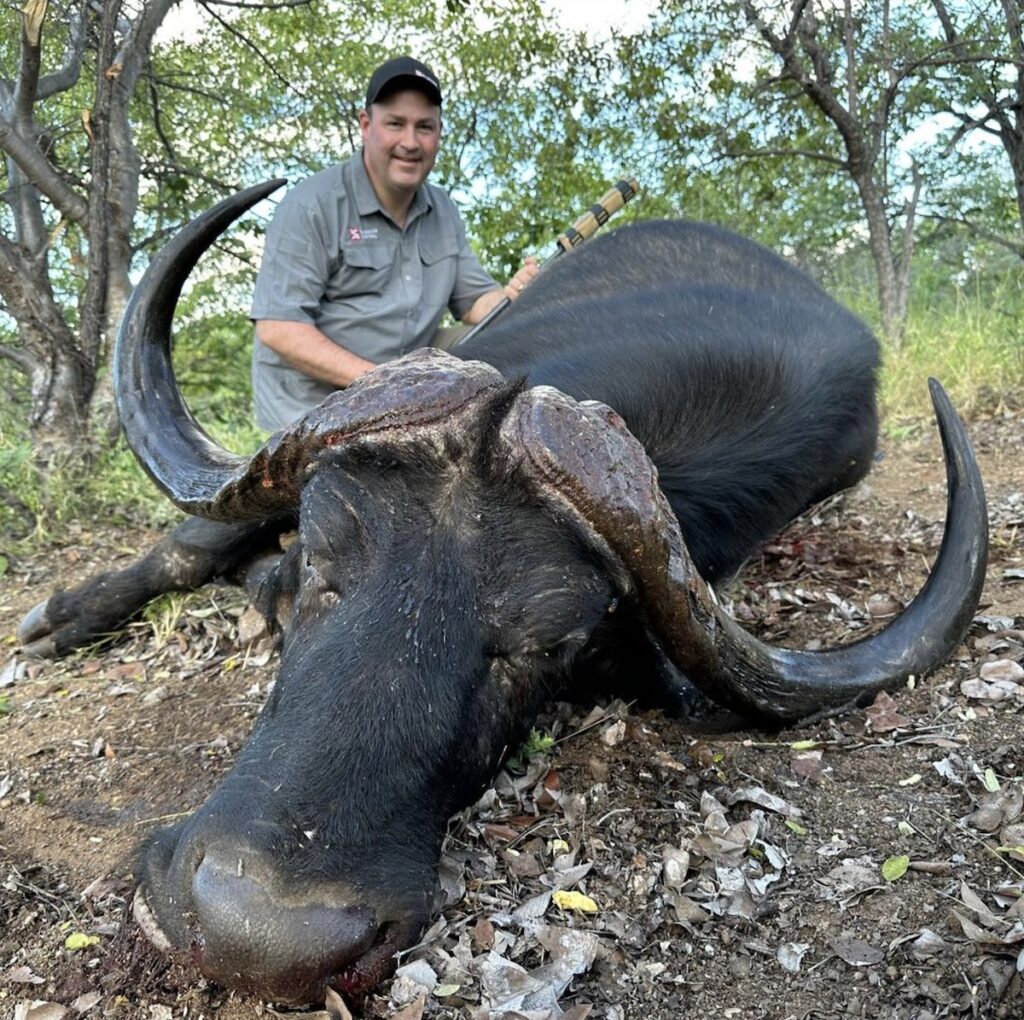
Are you looking for a great cartridge for sheep, mountain goat, or tahr hunting where you need an effective cartridge with manageable recoil in a lightweight and easy to carry rifle? Neither one of these cartridges is a good choice for this sort of situation. You have two choices if you’re planning a mountain hunt with a 300 PRC or a 338 Lapua: either suck it up and lug a heavy rifle up the mountain or deal with tremondous recoil in a lightweight rifle.
Remember what I said earlier about the guy who wanted a 7 pound 338 Lapua? No thank you.
I don’t like either cartridge for a hunt like this, but I’d give the nod to the 300 PRC here.
Actually you do have a 3rd choice here: you can choose a rifle cartridge with less recoil that’s better suited for a lightweight rifle (the 6.5 PRC or 7mm PRC are darn near perfect in my book depending on what you’re hunting).
Are you sensitive to recoil and in need of a serious low recoil cartridge? Once again, neither the 338 Lapua or 300 PRC is a good option here. The 300 PRC is definitely the better option for a lower recoiling round here, but it still has pretty stout recoil itself.
Some hunters can handle it. Others cannot. Fortunately there are lots of other rifle cartridges out there better suited for this sort of work for those that can’t deal with the recoil of either round.
300 PRC vs 338 Lapua Mag Final Thoughts
The 300 Precision Rifle Cartridge and the 338 Lapua Magnum are both excellent, heavy hitting long range rifle cartridges. Though there’s a tremendous amount of overlap in their ideal use cases, I have to give the nod to the 300 PRC as the better overall choice for hunting.
This is because the 300 PRC delivers an almost identical trajectory to the 338 Lapua, also has great performance in windy conditions, and also carries a tremendous amount of energy out to long range. Plus, it does so with a lot less recoil and using ammunition that’s less expensive.
Don’t get me wrong: the 338 Lapua will also work great for many of the same situations where the 300 PRC excels and is also quite a bit more powerful. However, the 300 PRC is such a heavy hitter itself that I’m not convinced the juice is worth the squeeze most of the time because it’s so much more expensive to shoot, because it recoils so much more, and because I’m not convinced most hunters really need the additional performance the 338 Lapua provides.
There’s no reason to go out and sell your 338 Lapua to buy a new 300 PRC rifle, but I’d steer most hunters looking for that sort of long distance hunting performance towards the 300 PRC.
But there’s also no reason why you can’t own and hunt with both either!
NEXT: 11 BEST HUNTING EAR PROTECTION OPTIONS FOR SPORTSMEN
NEXT: BEST GIFTS FOR HUNTERS
Enjoy this article comparing the 338 Lapua Magnum and 300 Precision Rifle Cartridges? Please share it with your friends on Facebook and Twitter.
The Lyman 50th Edition (p300-301), Hornady 10th Edition (p668-671), and Cartridges of the Wold (p139-140) were used as references for the history of the 338 Lapua Magnum cartridge. Hornady provided information for the history of the 300 PRC. The data used to compare the trajectory and recoil of the cartridges was obtained from Hornady’s web site (here and here) as well as the Barnes web site (here and here). Maximum pressure and data to compare cartridge sizes for the 300 PRC vs 338 Lapua Mag were obtained from SAAMI (here and here on p31). Case capacity information for the 300 PRC vs 338 Lapua Mag were obtained from Backfire.TV. Frontal surface area information was obtained from Chuck Hawks. I used Shooters Calculator to compare trajectories, wind drift, and recoil for the cartridges.
Make sure you subscribe to The Big Game Hunting Podcast and follow The Big Game Hunting Blog on Facebook, Instagram, Twitter, and YouTube.
John McAdams is a proficient blogger, experienced shooter, and long time hunter who has pursued big game in 8 different countries on 3 separate continents. John graduated from the United States Military Academy at West Point and is a veteran of combat tours with the US Army in Iraq & Afghanistan. In addition to founding and writing for The Big Game Hunting Blog, John has written for outdoor publications like Bear Hunting Magazine, The Texas State Rifle Association newsletter, Texas Wildlife Magazine, & Wide Open Spaces. Learn more about John here, read some of John’s most popular articles, and be sure to subscribe to his show: the Big Game Hunting Podcast.


